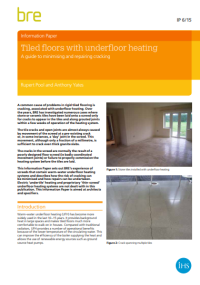Tiled floors with underfloor heating: A guide to minimising and repairing cracking
BRE (Building Research Establishment) is an independent, research-based consultancy, testing and training organisation, operating in the built environment and associated industries.
On 22 May 2015, BRE published Tiled floors with underfloor heating: A guide to minimising and repairing cracking (IP 6/15), by Rupert Pool and Tony Yates.
Warm-water underfloor heating (UFH) has become more widely used in the last 10–15 years. It provides background heat in large spaces and makes tiled floors much more comfortable to walk on in houses. Compared with traditional radiators, UFH provides a number of operational benefits because of the lower temperature of the circulating water. This can improve the efficiency of the boiler supplying the heat and allows the use of renewable energy sources such as ground source heat pumps.
However, cracking, associated with underfloor heating is a common cause of problems in rigid tiled flooring. BRE has investigated many cases where stone or ceramic tiles have been laid on screed only for cracks to appear in the tiles and along grouted joints within weeks of the heating system being operated. This is almost always caused by movement of the screed at a pre-existing crack or, in some instances, a ‘day’ joint in the screed. Even though this movement is just a fraction of a millimetre, it is sufficient to crack thick granite slabs. These cracks are normally the result of a poorly-designed floor screed (ie badly coordinated movement joints) or failure to properly commission the heating system before the tiles are laid.
This 8-page information paper sets out BRE’s experience of screeds that contain warm-water underfloor heating systems and describes how the risk of cracking can be minimised and how repairs can be undertaken. It is intended for architects and specifiers.
Its contents are:
- Introduction.
- Description of underfloor heating systems.
- Screed.
- Design of screed to incorporate underfloor heating.
- Problems that can occur.
- Crack-isolation systems.
- Commissioning the heating system.
- Checking a screed before the tiles are laid.
- Conclusions.
- References.
- Further reading.
Electric ‘undertile’ heating and proprietary ‘thin-screed’ underfloor heating systems are not dealt with.
[edit] Find out more.
[edit] Related articles on Designing Buildings Wiki
Featured articles and news
Retired firefighter cycles world to raise Grenfell funds
Leaving on 14 June 2025 Stephen will raise money for youth and schools through the Grenfell Foundation.
Key points for construction at a glance with industry reactions.
Functionality, visibility and sustainability
The simpler approach to specification.
Architects, architecture, buildings, and inspiration in film
The close ties between makers and the movies, with our long list of suggested viewing.
SELECT three-point plan for action issued to MSPs
Call for Scottish regulation, green skills and recognition of electrotechnical industry as part of a manifesto for Scottish Parliamentary elections.
UCEM becomes the University of the Built Environment
Major milestone in its 106-year history, follows recent merger with London School of Architecture (LSE).
Professional practical experience for Architects in training
The long process to transform the nature of education and professional practical experience in the Architecture profession following recent reports.
A people-first approach to retrofit
Moving away from the destructive paradigm of fabric-first.
International Electrician Day, 10 June 2025
Celebrating the role of electrical engineers from André-Marie Amperè, today and for the future.
New guide for clients launched at Houses of Parliament
'There has never been a more important time for clients to step up and ...ask the right questions'
The impact of recycled slate tiles
Innovation across the decades.
EPC changes for existing buildings
Changes and their context as the new RdSAP methodology comes into use from 15 June.
Skills England publishes Sector skills needs assessments
Priority areas relating to the built environment highlighted and described in brief.
BSRIA HVAC Market Watch - May 2025 Edition
Heat Pump Market Outlook: Policy, Performance & Refrigerant Trends for 2025–2028.
Committing to EDI in construction with CIOB
Built Environment professional bodies deepen commitment to EDI with two new signatories: CIAT and CICES.
Government Grenfell progress report at a glance
Line by line recomendation overview, with links to more details.
An engaging and lively review of his professional life.
Sustainable heating for listed buildings
A problem that needs to be approached intelligently.
50th Golden anniversary ECA Edmundson apprentice award
Deadline for entries has been extended to Friday 27 June, so don't miss out!
CIAT at the London Festival of Architecture
Designing for Everyone: Breaking Barriers in Inclusive Architecture.
Mixed reactions to apprenticeship and skills reform 2025
A 'welcome shift' for some and a 'backwards step' for others.





























